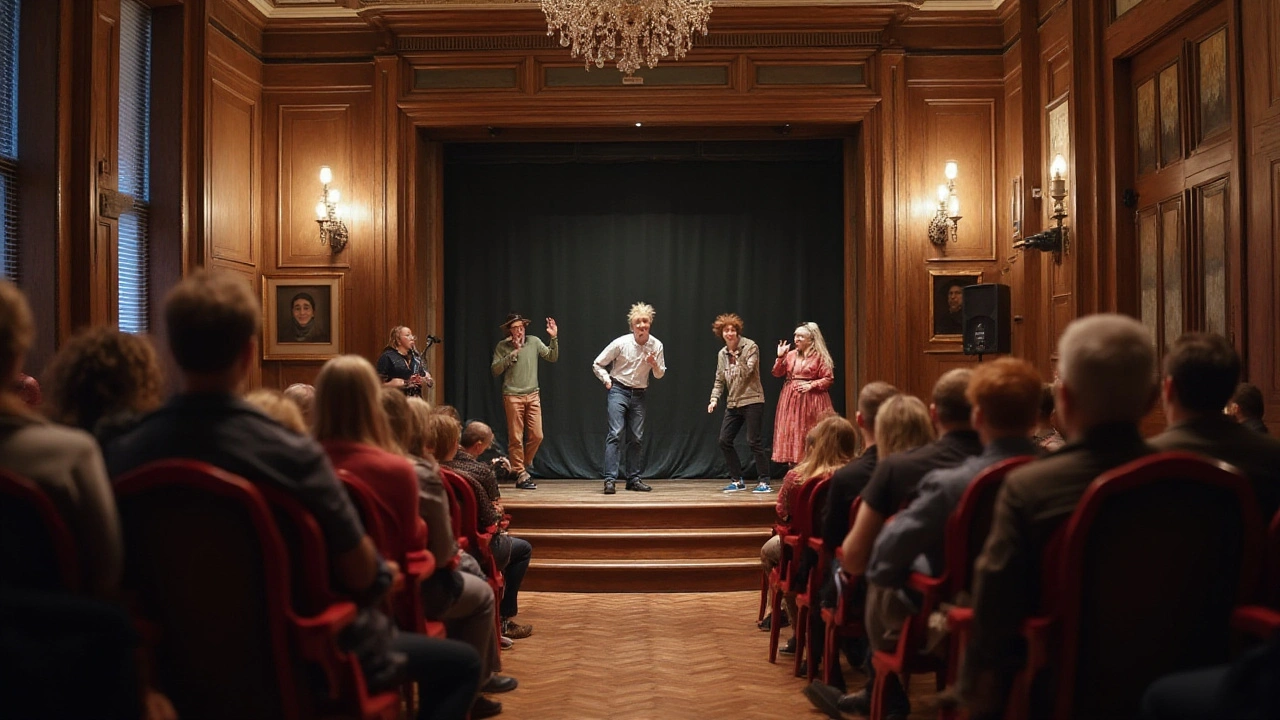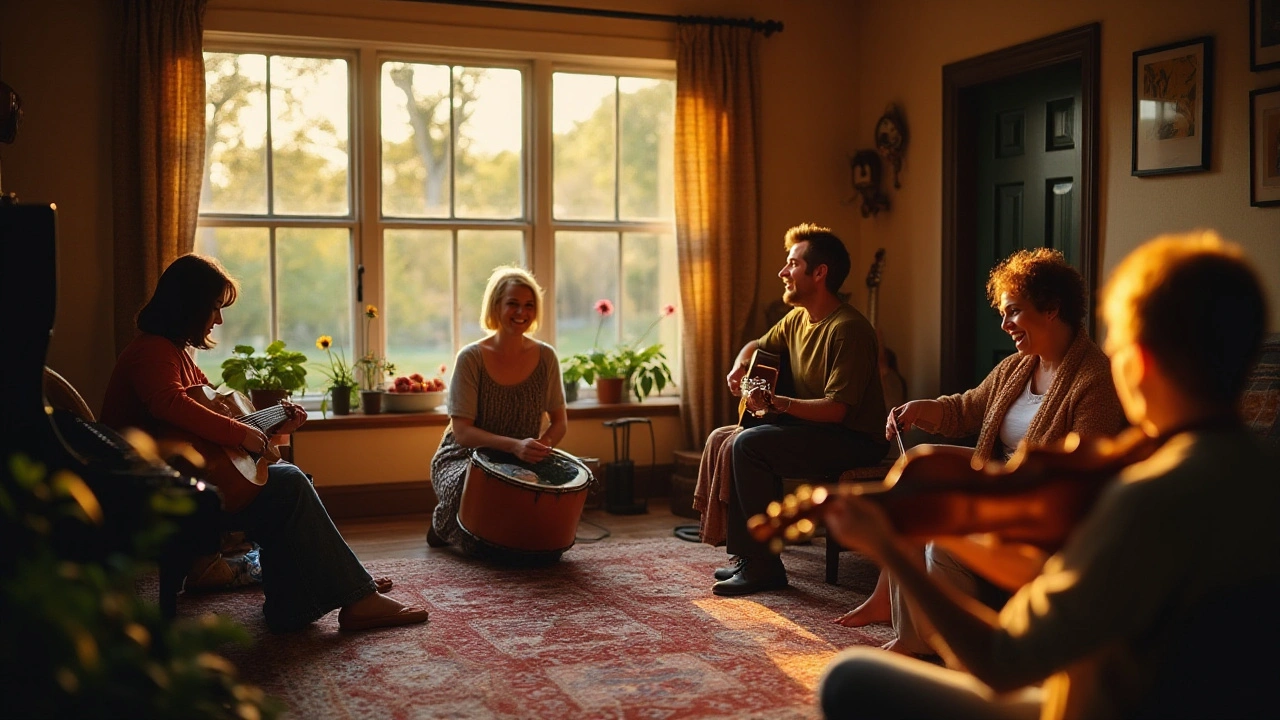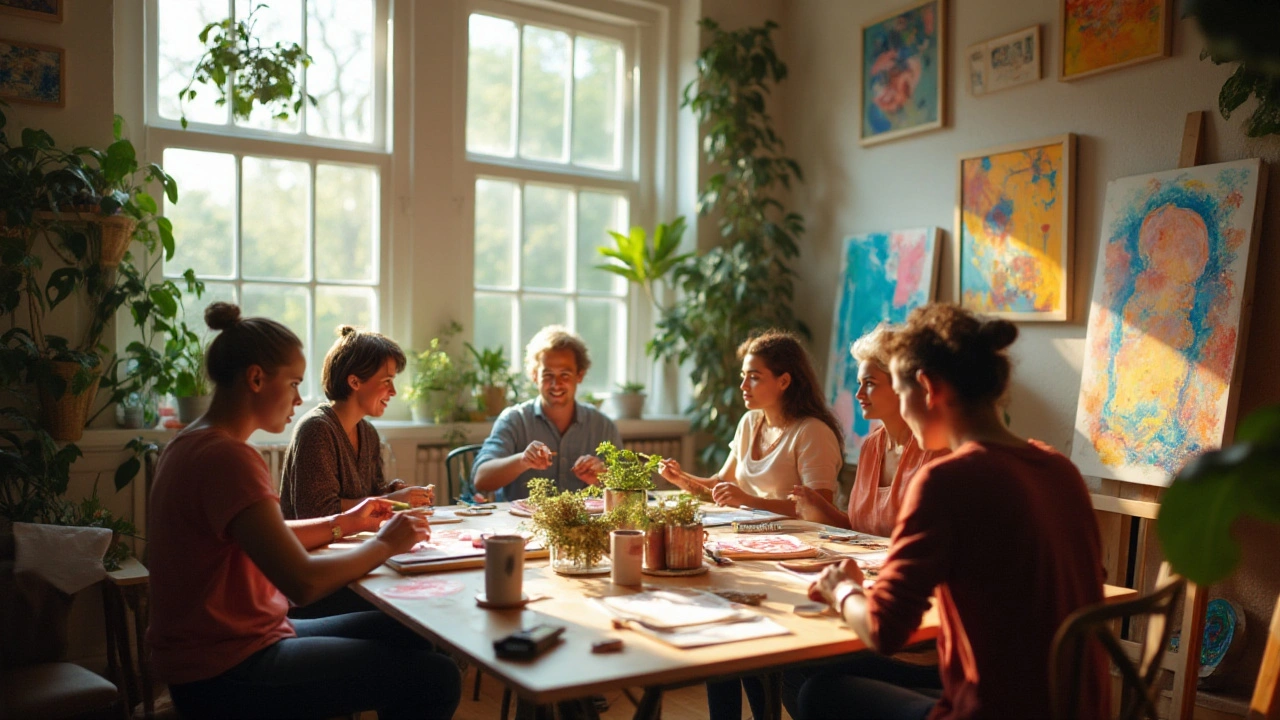Creative arts therapies offer a vibrant avenue for emotional expression and mental well-being. Going beyond traditional talk therapies, these practices enlist the healing power of creativity through art, music, drama, and dance. Each modality taps into different aspects of our emotional and psychological selves, providing diverse pathways to healing and self-discovery.
People often find that these therapies allow for expression without the need for words, which can be particularly liberating for those who find verbalizing their feelings challenging. Delving into the world of creative arts therapies unlocks a treasure trove of potential for emotional growth and healing, inviting individuals to explore their inner landscapes in new and exciting ways.
- Understanding Creative Arts Therapies
- Types of Creative Arts Therapies
- Benefits for Emotional Well-being
- Real-world Examples and Success Stories
- Tips for Incorporating Creative Arts Therapies
Understanding Creative Arts Therapies
Creative arts therapies denote a collection of therapeutic approaches that utilize artistic processes to assist individuals in addressing psychological and emotional challenges. While this area might appear novel to some, the integration of art forms into therapeutic settings has roots that stretch back to the mid-20th century. Figures such as Margaret Naumburg, often recognized as the founder of art therapy, paved the way for acknowledging the profound impact of these practices. Each method within this field—be it art, music, drama, or dance—works towards facilitating expression, catharsis, and healing through a medium deeply intertwined with human creativity. Importantly, these therapies do not require participants to have previous experience in the arts, opening the door for many to explore and express feelings that may be challenging to verbalize.
What uniquely characterizes these therapies is their ability to transcend the boundaries of verbal communication. Often, words are insufficient to capture the nuance of certain emotional states or past experiences. Art therapies carve out a space for symbolism and metaphor, enabling thoughts and emotions to be externalized through creative processes. This externalization can be particularly freeing, offering a physical representation of inner experiences that can be analyzed, discussed, and processed from a more objective standpoint. By providing a tangible output of one's internal world, creative arts therapies make the abstract more concrete, offering people a new way to confront and understand their feelings.
"Art washes away from the soul the dust of everyday life," noted the legendary artist Pablo Picasso, highlighting the essential cathartic role that art can play in personal well-being.
The rise of creative arts therapies is underpinned by a growing body of research affirming their efficacy. Studies consistently reveal improvements in emotional well-being among participants, along with reductions in symptoms of anxiety, depression, and stress. Addressing trauma is another area where these therapies have proven impactful. By providing a safe and nurturing environment, individuals are empowered to revisit and reinterpret traumatic experiences in a manner that promotes healing. This non-invasive approach helps rebuild a sense of trust and security, facilitating progress through aspects of trauma recovery at a pace suited to each individual.
For practitioners of creative arts therapies, the process involves more than merely engaging with art forms. They must navigate the delicate balance between guiding the therapeutic process and allowing clients the autonomy to explore their creativity. A therapist's sensitivity and skill in interpreting the rich layers of meaning that emerge from art, music, or drama are crucial to the therapy's success. This multifaceted approach makes it possible to tailor the therapy to each person's needs, reinforcing the importance of individualized treatment plans. As interest in holistic mental health care grows, creative arts therapies are moving to the fore, offering dynamic and adaptive solutions for emotional and psychological challenges.
Types of Creative Arts Therapies
Creative arts therapies are broad and diverse, encompassing various artistic disciplines to aid emotional well-being. Each type of therapy offers unique benefits and can tap into different facets of human emotions, mental health, and personal growth. One of the most well-known types is art therapy, where visual arts such as drawing, painting, and sculpting are used as a medium for expression. This therapy is particularly effective for those who may have difficulty articulating their emotions or experiences through words. Through creating art, individuals can express underlying thoughts and feelings in a tangible form, providing a new perspective on their internal landscapes. Art therapy has been shown to alleviate the symptoms of anxiety, depression, and trauma by giving patients a safe space to explore their emotions.
Another prominent form is music therapy, which harnesses the power of sound and rhythm to connect with the emotional core of individuals. Music has a universal quality that transcends language, offering a unique therapeutic avenue for people of all ages and backgrounds. Whether through listening, composing, or playing instruments, music therapy can help reduce stress, enhance cognitive functions, and elevate mood. It can be particularly beneficial for people with conditions such as autism, schizophrenia, or Alzheimer's disease. A significant benefit of music therapy is its ability to promote social interaction and cohesion, which can be empowering for individuals who may feel isolated by their mental health challenges.
Then there's drama therapy, which uses role-play, storytelling, and theatrical performance as methods of therapeutic intervention. This branch of therapy encourages participants to step into new roles, allowing them to explore different perspectives and emotions in a safe and supportive environment. Through drama, individuals can gain insight into their behaviors and relationships by externalizing their problems and viewing them from a new angle. Drama therapy can be particularly beneficial in group settings, enhancing empathy and understanding among participants and fostering a sense of community and support.
Dance and movement therapy focuses on the use of bodily movement as a form of expression, aiming to improve physical, emotional, and mental health. By allowing individuals to express their feelings through movement, this therapy can help release pent-up emotions and relieve stress. It provides an opportunity for individuals to reconnect with their bodies, promoting self-awareness and self-esteem. Studies have shown that dance therapy can help reduce symptoms of depression, improve body image, and increase feelings of vitality and well-being. In a world where people are increasingly sedentary, the physical activity involved in dance therapy adds an additional layer of health benefits.
Another emerging type of creative arts therapy is expressive arts therapy, which combines multiple art forms such as music, drama, and visual arts to help individuals explore emotions and problems. This integrative approach allows for flexibility and personalization, making it suitable for a wide range of populations and issues. By using a variety of art forms, expressive arts therapy can reach individuals who may not resonate with a single artistic modality. The collaborative nature of this therapy encourages creativity and spontaneity, empowering individuals to venture into new emotional and artistic territories.

Benefits for Emotional Well-being
Creative arts therapies represent a profound way to harness the transformative power of art in promoting emotional well-being. These therapies enable individuals to reconnect with their emotional selves, often providing relief when traditional verbal therapy falls short. One key benefit is that they allow people to express complex feelings through creative outlets. Sometimes, finding the right words to describe emotions can be tough. Art, music, or dance can fill this gap, giving form and color to what’s inside.
Engaging in creative arts therapies can lead to significant reductions in anxiety and stress levels. It turns out that when we immerse ourselves in creating, our brains produce dopamine, often known as the 'feel-good' neurotransmitter. This not only boosts our mood but also helps in building resilience against emotional challenges. This is corroborated by various studies that illustrate how engaging in art can decrease the stress hormone cortisol, leaving individuals feeling more relaxed and balanced.
These therapies can also be highly beneficial in processing trauma, as they often allow individuals to explore their experiences in a safe and nonjudgmental environment. When individuals create, they often find it easier to open up about painful memories, which helps in reducing the weight of these experiences and moving toward healing. Art becomes a powerful bridge to connect with deep emotions that might otherwise remain buried.
According to a report from the American Art Therapy Association, 'Art therapy is often the key to unlocking emotions that have been long buried, providing a valuable outlet for self-expression and healing.' This illustrates the unique ability of these therapies to touch aspects of our psyche that are resistant to conventional methods.
Moreover, creative arts therapies can play a critical role in enhancing self-awareness. As individuals engage in creative processes, they gain insights into patterns of behavior and thought that might be contributing to emotional distress. This heightened awareness can lead to more mindful and conscious living, fostering growth and change. In group settings, shared creative activities can also strengthen social bonds and reduce feelings of isolation, proving that the impact of creative arts therapies extends beyond the individual to the community.
There's growing evidence that these therapies can also have a preventive effect, helping maintain well-being before issues arise. Regular creative practice can act as a stress reliever, contributing to sustained emotional balance. In fact, a study published in the Journal of Public Health suggested that individuals who regularly engage in arts-related activities report higher levels of happiness and life satisfaction. Such compelling evidence underscores the importance of integrating creative arts therapies into mental health support systems.
Real-world Examples and Success Stories
Creative arts therapies have woven their transformative threads through countless lives around the globe, offering healing that feels both profound and mesmerizing. One story that captures the essence of this healing comes from a retired war veteran named Ben. After returning home, like many others, he struggled with overwhelming trauma. Traditional talk therapies seemed to only scratch the surface of his profound PTSD. When Ben stumbled upon creative arts therapy, he was hesitant. However, taking the plunge into visual arts allowed him to express emotions that words failed to capture. Each brush stroke seemed to peel back a layer of anguish, revealing a more peaceful self. Over time, painting became not just therapy, but a cherished part of his life, underscoring the immense potential of artistic expression in reclaiming emotional stability.
In another heartwarming instance, children diagnosed with autism have found their voices through therapeutic art programs. Jenny, a vibrant 9-year-old, was mostly non-verbal until music therapy began lighting up her world. Her music therapist used familiar tunes to engage her, eventually composing simple songs centered around her day-to-day life. Singing these songs became Jenny's way of communicating, helping her connect with her family in ways previously unimaginable. The ripple effect of such a breakthrough spills over into many facets of life, enhancing not only the child's experiences but reshaping whole family dynamics.
The global embrace of music therapy has led to profound change in mental health care facilities. National Health Services in England reported a remarkable 42% improvement in patients' mood and emotional well-being through their music-led programs. The power of a shared rhythm and collective sound acts as a comforting echo of support that lingers long after the sessions end. What is astounding is the sense of community these sessions foster. Patients often carry these songs with them, continuing their healing journey beyond the therapy rooms.
"Creative arts therapies hold the potential to unlock feelings and stories that lie buried deeper than words," remarked Jane Liepa, director of the Melbourne Creative Arts Centre. This insight reveals how deeply art can delve into the emotional tapestry of our lives, offering glimpses into the stories and healing pathways waiting to be unearthed.
Real-world examples like these highlight the transformative influences that creative arts therapies can wield. Whether it's through a paintbrush, musical notes, or dramatic role-plays, each medium offers a gateway to newfound emotional freedom and healing. Engaging in creative arts therapy isn't merely about creating art; it becomes a sacred ritual of self-discovery, offering a canvas upon which individuals can reflect, heal, and grow.

Tips for Incorporating Creative Arts Therapies
Incorporating creative arts therapy into everyday life can be a transformative journey, not just for individuals looking for emotional relief but also for those in search of a creative outlet. Creative arts therapies are accessible to everyone, regardless of artistic skill level. What's essential is the willingness to express oneself and explore emotions through art forms like painting, music, or movement. Consider setting aside regular time to explore your chosen medium, creating a space free of judgment and pressure. This practice can be incredibly freeing and therapeutic as it allows you to tap into your inner thoughts and feelings in a way that's safe and structured.
One effective way to get started is to follow simple guided exercises designed to unlock creativity and encourage self-discovery. For example, art journaling can serve as a fantastic tool for anyone. It's about splashing colors, scribbling thoughts, and pasting whatever feels significant at the moment, without any rules. If you're musically inclined, playing an instrument or engaging in free-form vocalization can serve as a powerful outlet. If drama or dance is more up your alley, creating personal stories or movements that map to your emotions can help express inner experiences profoundly.
For those looking to delve deeper, attending workshops or group sessions facilitated by a certified therapist may introduce new techniques and processes tailored to your specific needs. Group settings can offer the added benefit of shared experiences and insights. Art therapy groups, for instance, provide a communal space to create and reflect collectively, often leading to breakthrough moments and collective support. Don't hesitate to explore various modalities to discover what resonates most; after all, creative arts therapy is about personal expression and finding what feels right for you.
Incorporating creative arts into community spaces can also enhance emotional well-being across wider groups. According to the Australian National Arts Participation Survey, engaging with the arts can lead to a more connected community. Whether organizing community mural projects or music jams, collaborative activities may foster a sense of belonging, reducing stress and elevating collective mood. Remember, the key is to keep the process inclusive and expressive rather than focusing on the end product. This communal engagement can transform local environments and individual lives alike, creating a ripple effect of positivity.
"Art is not a mirror held up to reality, but a hammer with which to shape it." – Bertolt BrechtEmbrace this idea as you integrate creative arts therapies into daily life. Remember, it's less about the aesthetic and more about using creativity as a means to connect with inner thoughts and emotions. Journals, painting canvases, or dance floors – these spaces are the canvases of emotional learning and self-discovery. As you embark on this journey, let go of preconceived notions and embrace the therapeutic power of art in its endless forms.
